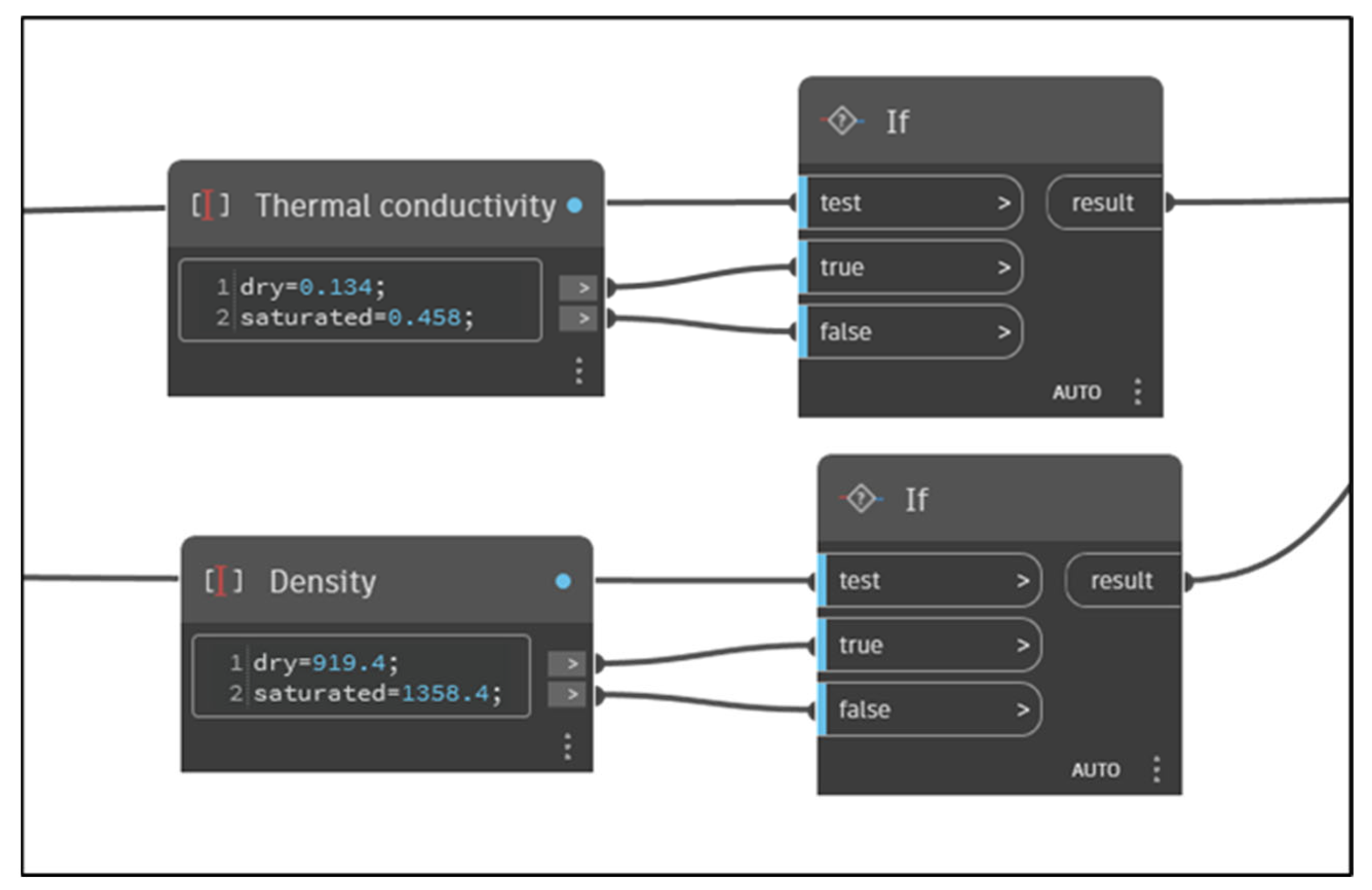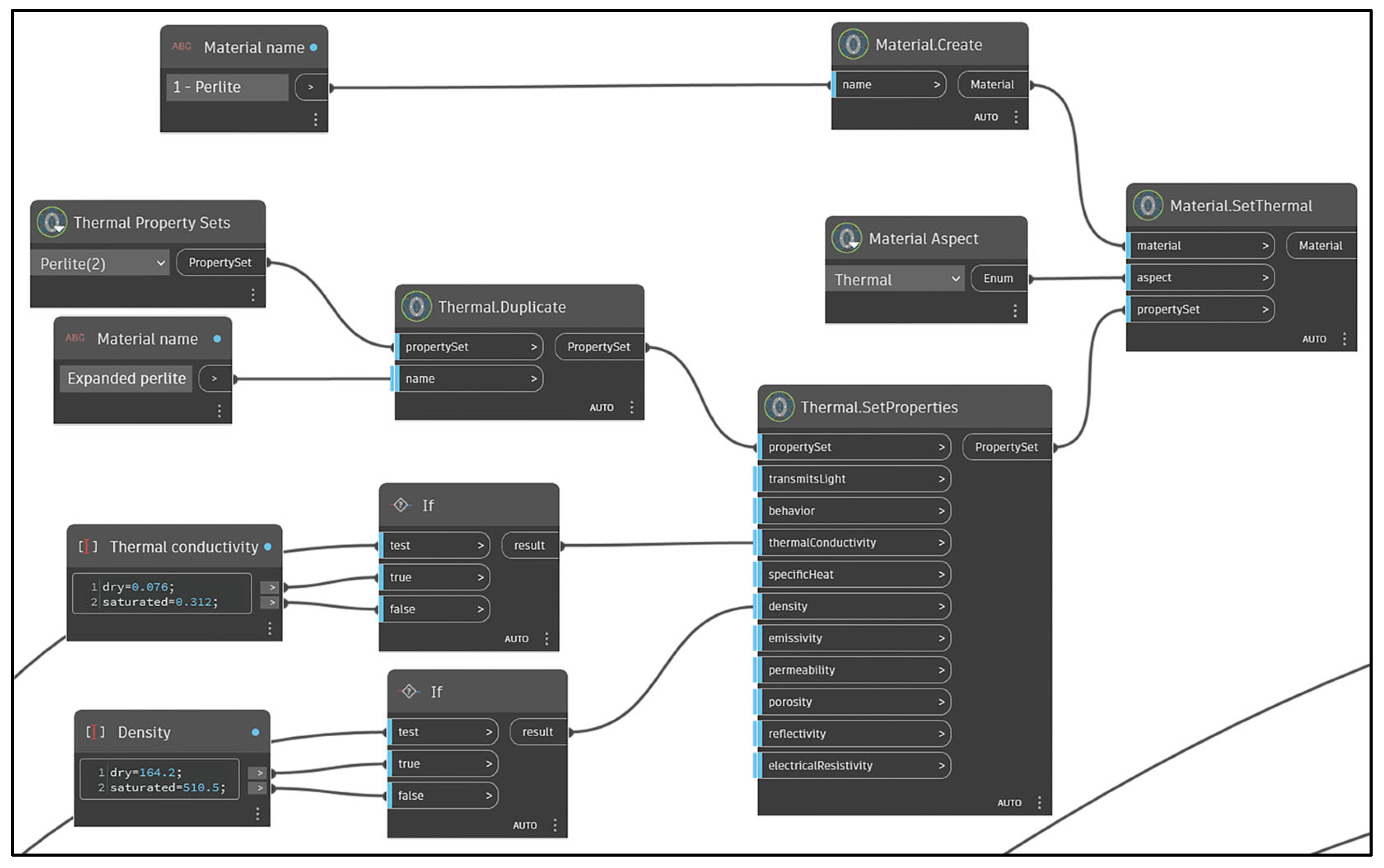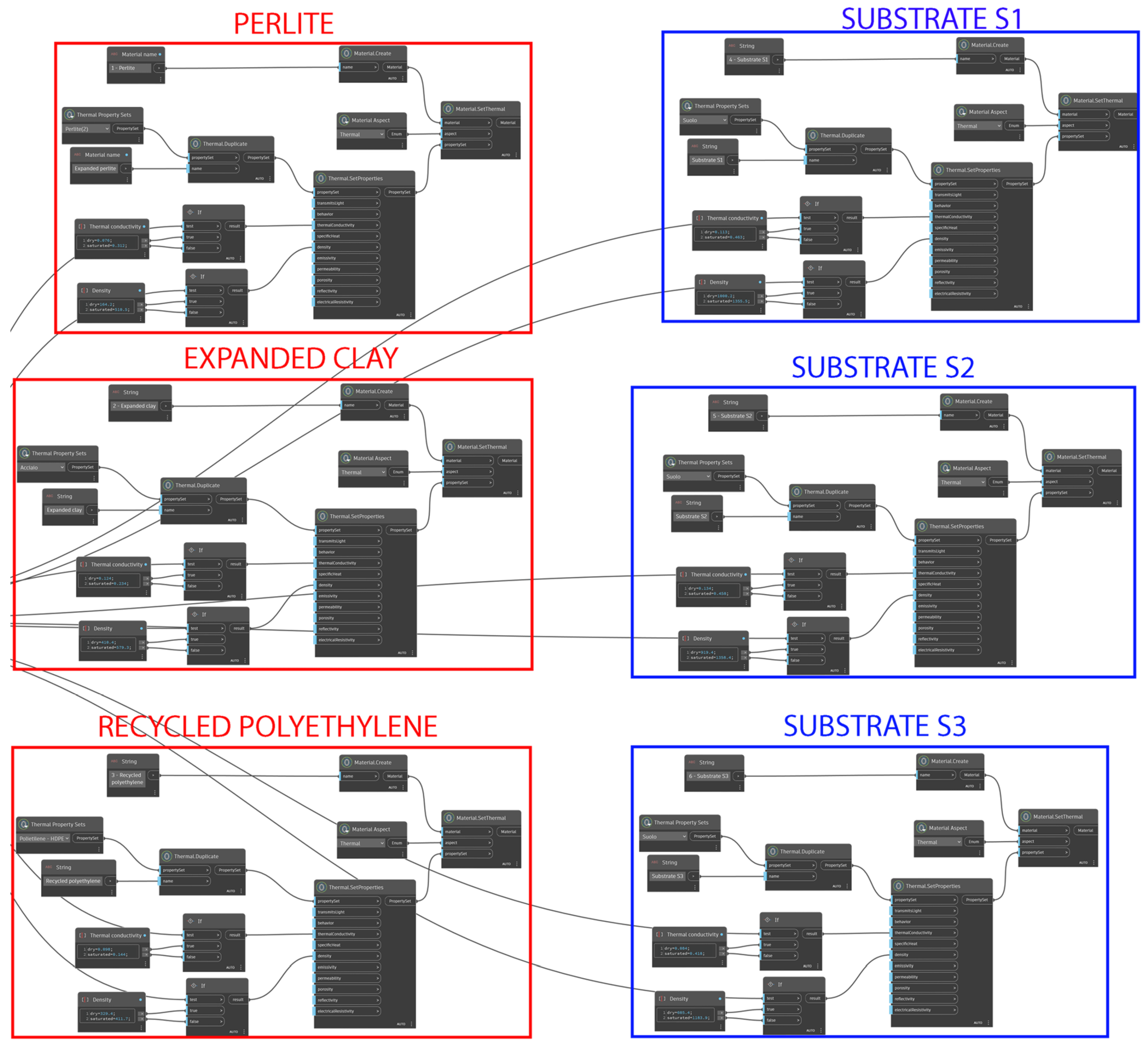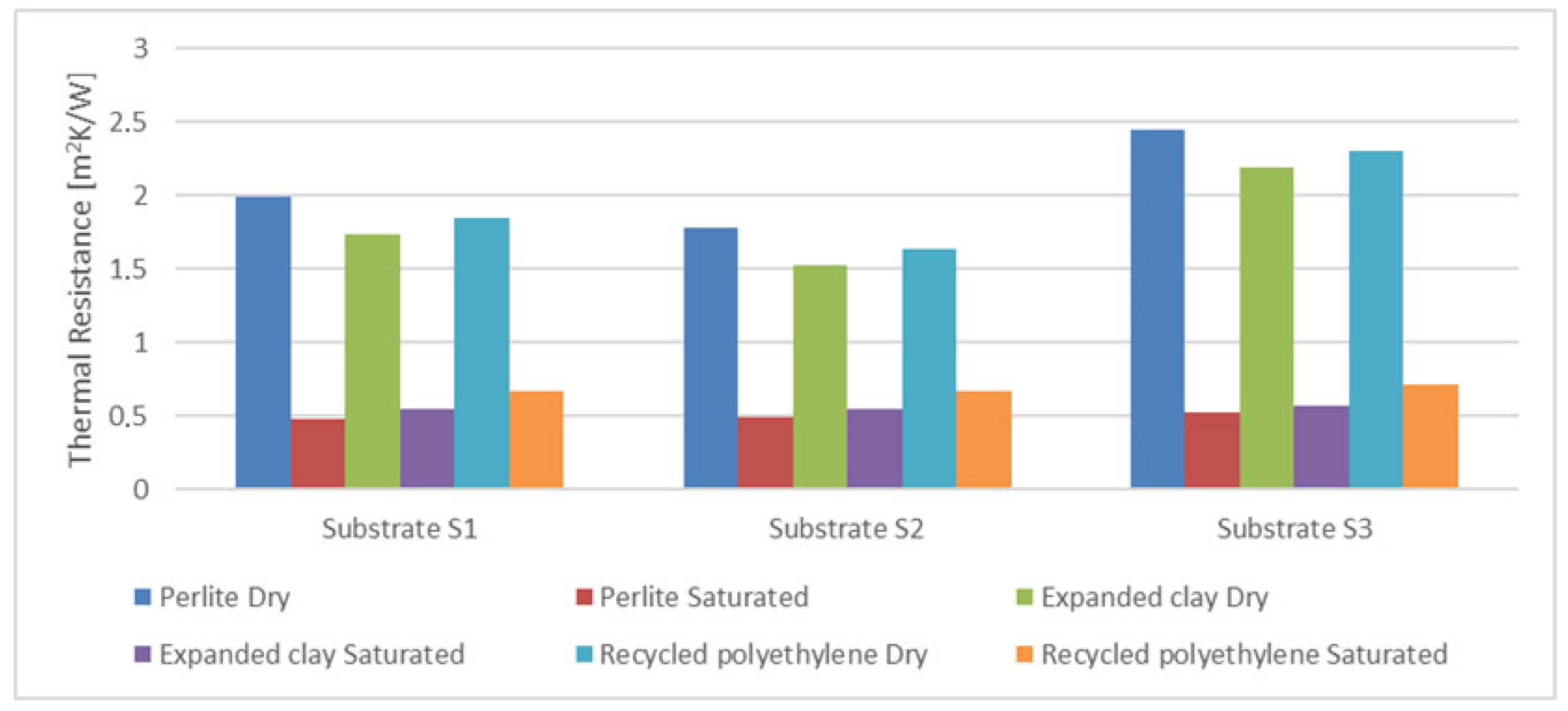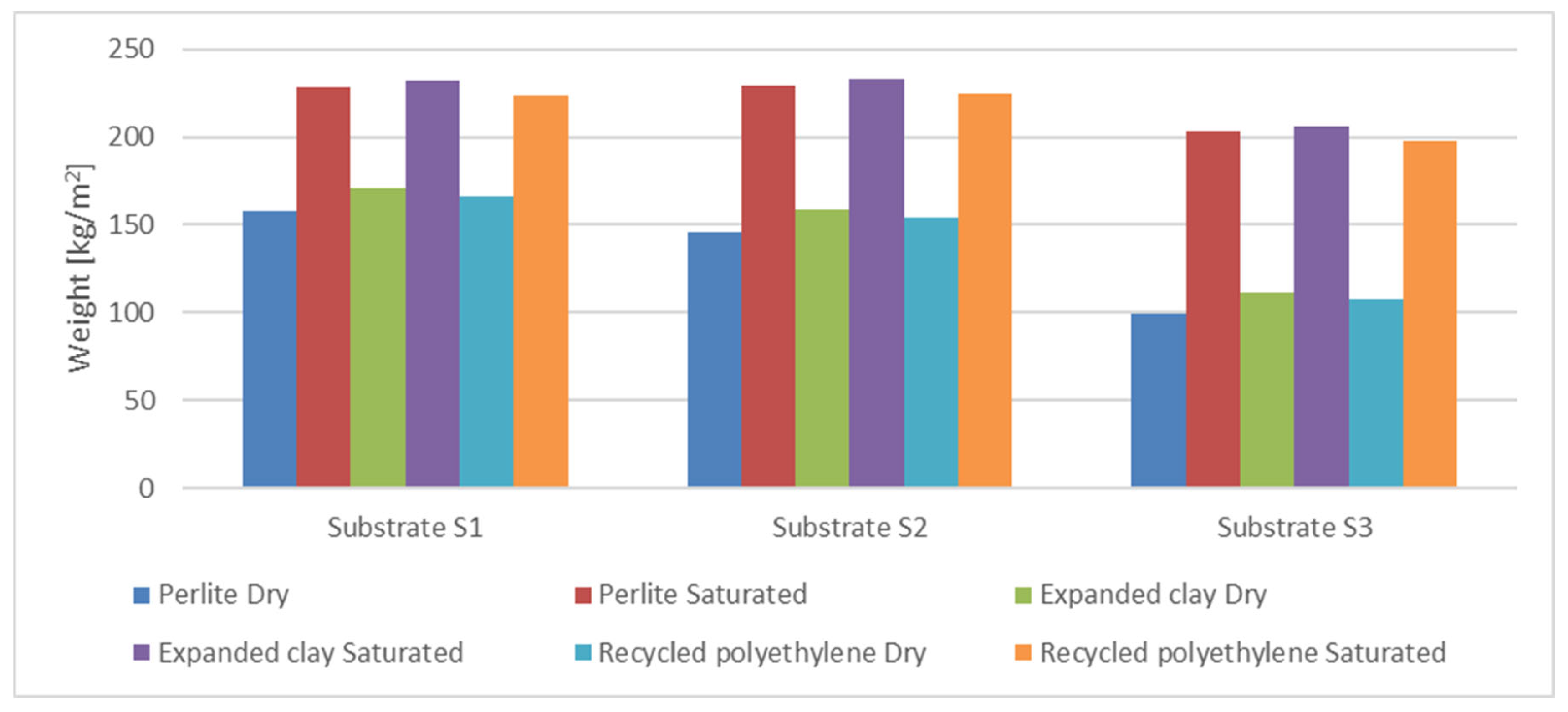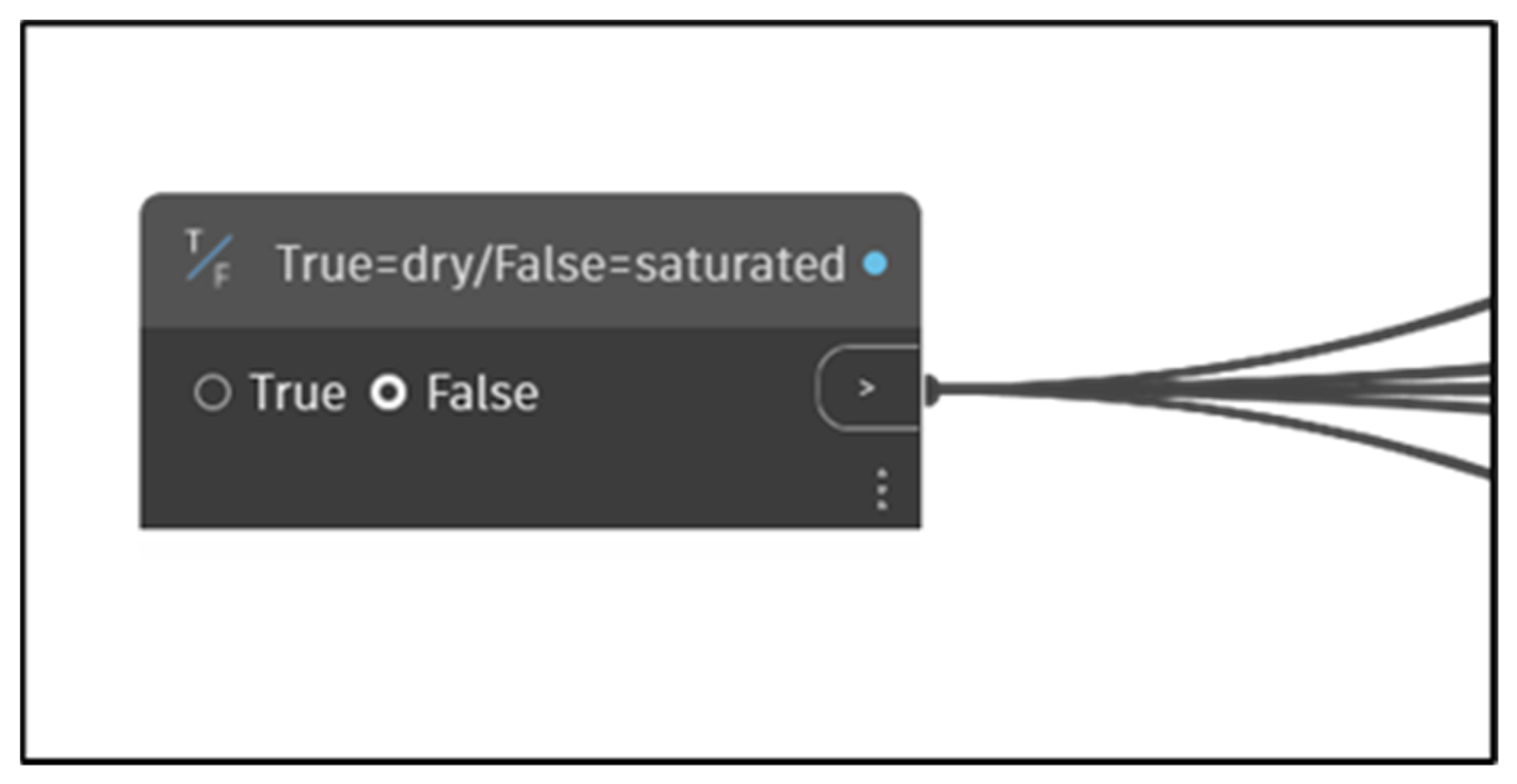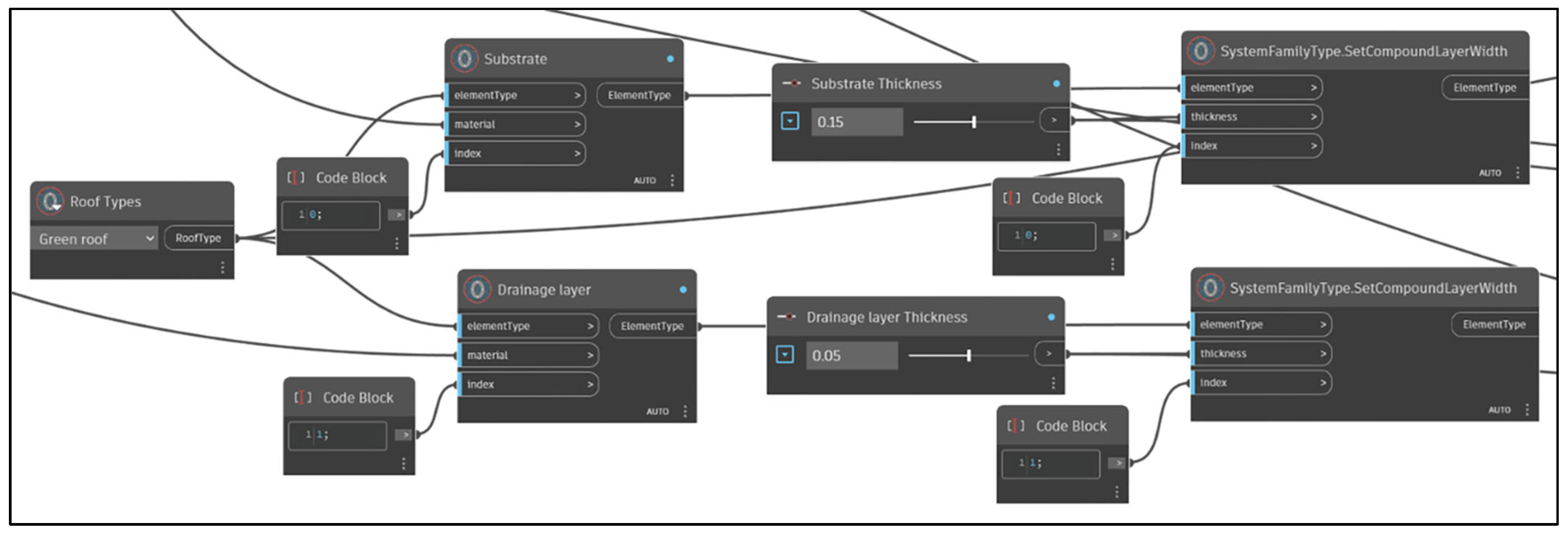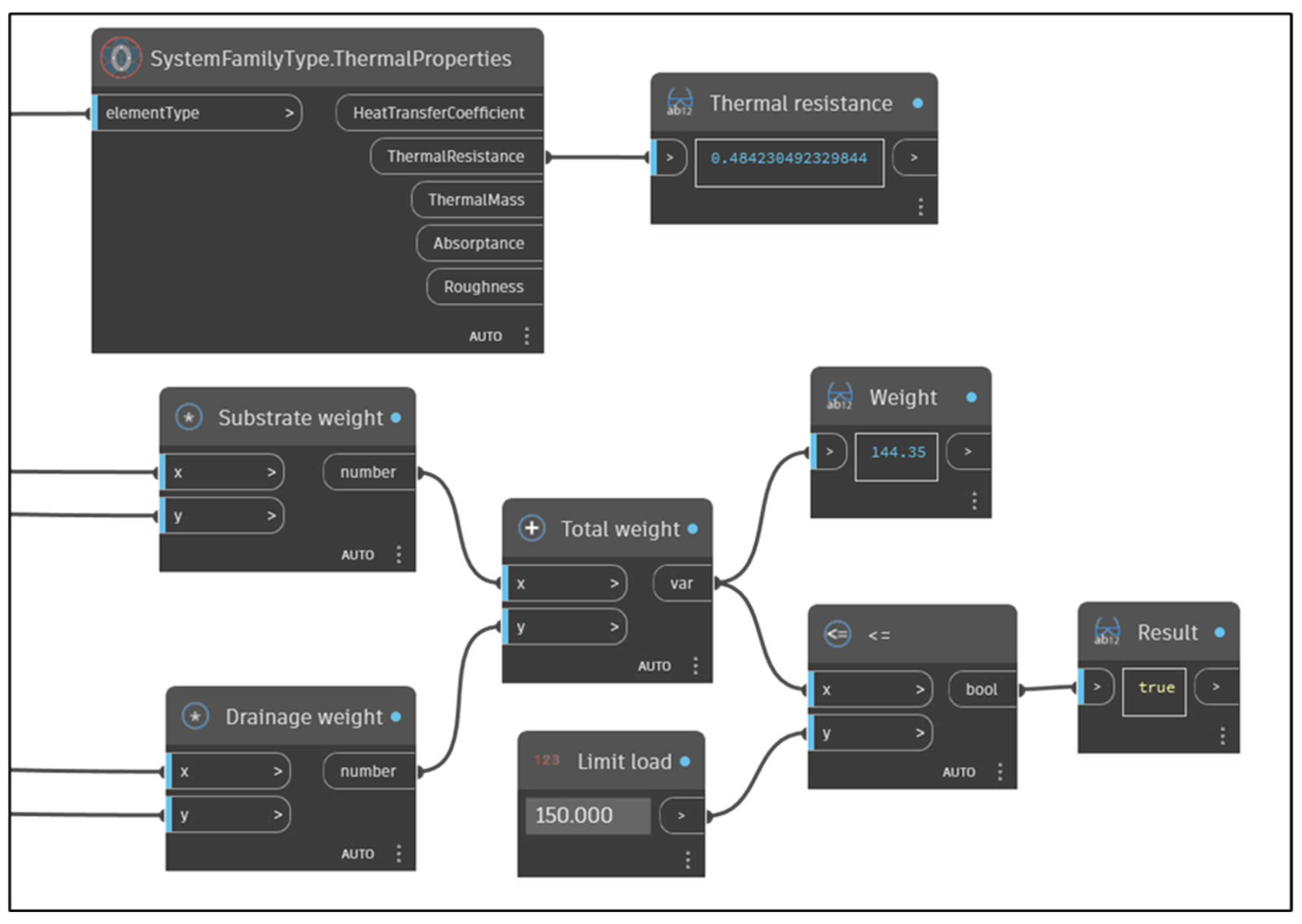1. Introduction
The construction industry is at a pivotal moment, aligning with the United Nations Sustainable Development Goals, especially Goal 11: Sustainable Cities and Communities. This alignment addresses global challenges like climate change and resource depletion, marking a proactive stride towards sustainable urban living [
1].
This transformative era is driven by technological innovations, paralleling initiatives like the European Union’s Digital Single Market strategy [
2,
3]. Central to this evolution is Building Information Modeling (BIM), reshaping construction into a domain of efficiency and collaboration [
4].
Green roofs, essential in sustainable architecture, are gaining recognition for their role in urban environmental management [
5]. These living roofs blend vegetation with structural elements, offering environmental, social, and economic benefits [
6,
7]. Their integration with BIM represents a new frontier in urban construction, enhancing urban spaces and ecosystem resilience [
8]. Despite the growing recognition of green roofs, their integration with BIM technology remains in its infancy. Prior research has highlighted the potential synergies between green roofs and BIM, yet a comprehensive integration strategy that encompasses the dynamic thermal behavior of green roofs is often lacking. The traditional steady-state, U-value approach, while beneficial, does not fully capture the complex heat transfer processes of green roofs, including both sensible and latent heat flows.
This research proposes an integrative framework combining green roof technology with BIM, highlighting the necessity for dynamic thermal analysis to accurately represent green roofs’ thermal performance, thereby contributing to sustainable urban development. Through case studies spanning diverse geographical locations and climatic conditions, this study illustrates the adaptability and effectiveness of BIM-integrated green roofs. These examples underscore the potential of such integration to enhance urban spaces and ecosystem resilience, demonstrating a new frontier in urban construction that aligns with the environmental dimension of sustainable development.
The objectives of this research are to:
Develop a model that integrates ecological design with digital technology, moving beyond traditional construction practices.
Introduce a computational modeling approach using Dynamo Visual Programming Language (v.2.17.0) within Autodesk Revit for green roof applications, offering customization.
Conduct detailed assessments of green roof performance in diverse environments to advance current evaluations.
Establish best practices and guidelines for the integration of green roofs with BIM, promoting their broader adoption.
By addressing these objectives, this study contributes to filling the identified research gaps, namely the need for a comprehensive integration of green roofs with BIM and the application of dynamic thermal analysis. It aligns with the underlying theories of sustainable urban development, such as the Triple Bottom Line and Urban Resilience Frameworks, highlighting the project’s multidimensional contributions to environmental sustainability, economic viability, and social well-being in urban development.
2. Literature Review
The integration of green roof design elements and parameters with BIM is evolving within sustainable urban development. While foundational knowledge has been established, there has been a tendency to overlook the comprehensive integration of dynamic thermal behaviors of green roofs within BIM frameworks, particularly in early planning and design stages. Traditional studies have explored technical aspects of incorporating green roof systems into BIM, focusing on post-design benefits and optimization for energy efficiency. However, these approaches often miss capturing the complex interactions of sensible and latent heat flows that are crucial for accurately evaluating green roof performance.
Initial studies, such as those by Korol et al. [
9] and Yu et al. [
10], have been instrumental in exploring the technical aspects of incorporating green roof systems into BIM. Korol et al. [
9] focused on the complexities of creating BIM objects for green roof systems, highlighting the need for sophisticated software solutions like AECOsim and ARCHICAD. Yu et al. [
10], on the other hand, examined the integration of BIM with energy consumption analysis in green roof projects, offering insights into the optimization of green roof designs for enhanced energy efficiency. However, these studies predominantly address post-design benefits and lack a holistic approach to green roof integration, especially in the initial planning and design stages.
Recent studies have shed light on the importance of addressing these dynamic thermal processes. Arkar et al. [
11] highlighted how water freezing in the substrate could enhance energy efficiency. Zhou et al. [
12] improved simulation accuracy by incorporating seasonal vegetation changes, and Yang et al. [
13] demonstrated the benefits of evapotranspiration in moderating heat flow through extensive green roof models. Heusinger et al. [
14] showed that sustainable irrigation could significantly boost evapotranspiration rates, aiding in urban heat mitigation.
Green roofs are complex living structures that provide a range of ecological benefits, including biodiversity enhancement [
15], urban heat island mitigation [
16], and improved air quality [
17]. Their contribution to a building’s thermal and energy performance extends beyond mere thermal resistance [
18]. Jaffal et al. [
19] demonstrated that they reduce roof heat losses during cold days and can decrease summer indoor air temperature by 2 °C, improving building energy performance. It involves intricate interactions between vegetation types, soil composition, water cycles, and their effects on urban microclimates. The synthesis of these findings underscores the importance of considering both direct and indirect benefits of green roofs to fully appreciate their economic efficiency. While the initial costs and maintenance can be significant [
20], the long-term benefits, including energy savings, environmental improvements, and public health outcomes [
21], suggest that green roofs can be a cost-effective solution for urban sustainability when implemented under favorable conditions.
To this end, advancements in BIM technology, such as those enabled by Dynamo within Autodesk Revit, offer new possibilities for modeling these dynamic aspects of green roofs. Dynamo allows for the research and design of green wall systems, which can be extended to green roofs. Briscoe [
22] included the modeling of plant growth patterns and the interaction of plants with their environment. Dynamo accelerates design processes and enables more efficient modeling of green roofs, including aspects such as plant growth and water cycles [
23]. A comprehensive BIM approach can thus encapsulate the multifaceted characteristics of green roofs, from ecological impacts to thermal efficiency and sustainability.
BIM technology now enables a more nuanced approach to green roof design. This includes capabilities for detailed site analysis, which allows for the optimization of green roof placement based on environmental conditions such as sunlight exposure and wind patterns. BIM-based evaluation systems can quickly conduct green building evaluations and optimize performance, potentially reducing energy consumption and creating more comfortable environments for occupants [
24]. BIM technology supports the design, construction, operation, and retrofitting processes of green buildings, offering various functions for green building analyses like energy, emissions, and ventilation analysis [
25].
The selection of plant species and their specific needs concerning water, sunlight, and soil composition can also be more accurately modeled in BIM, facilitating an ecologically viable design. Yang [
26] and Lee [
27] used BIM technology to accurately model the specific needs of plant species for green roof design, thereby facilitating sustainability.
Furthermore, BIM’s powerful tools for structural analysis are critical for assessing the load-bearing capacity of buildings, ensuring they can support the weight of vegetation and growing media, an aspect that is crucial for the feasibility of green roof projects [
27].
Other research efforts, such as those by Kasmion et al. [
28], Sharma and Kumar [
29], Cascone and Leuzzo [
30], and Uddin et al. [
31], provide insights into specific aspects of green roof design using BIM, including performance analysis and material selection.
Despite these technological advancements, the literature reveals a scarcity of standardized guidelines and best practices in integrating these complex, living elements of green roofs into BIM models. This gap signifies a missed opportunity for leveraging BIM’s full potential in green roof projects, from conceptual design to maintenance.
These insights point towards the necessity for BIM to adopt a more nuanced approach that includes dynamic thermal analysis, allowing for a realistic simulation of green roofs’ thermal performance over time. The use of Dynamo within Autodesk Revit emerges as a promising tool in this context, enabling the design and simulation of green roofs’ dynamic aspects, such as plant growth patterns and water cycles. This research advocates for the integration of such dynamic thermal analyses into BIM frameworks, paving the way for more accurate, efficient, and sustainable green roof designs in urban development.
3. Materials and Methods
3.1. Selection of Green Roof Materials
The selection of materials for green roofs in this study emphasizes environmental sustainability, performance efficiency, and practical feasibility [
32]. The rationale for choosing specific materials is grounded in their varied responses to environmental conditions, which directly impact the thermal and structural integrity of green roofs.
Drainage Layer Materials: Perlite, expanded clay, and recycled polyethylene were chosen due to their effectiveness in stormwater management and availability. Perlite and expanded clay offer different water retention and drainage capacities, essential for understanding moisture behavior in green roofs. Recycled polyethylene is included to explore the feasibility of using sustainable materials in green roof construction, which aligns with the growing emphasis on eco-friendly building practices.
Substrate Materials: A diverse range of substrates, comprising mineral and organic compositions, was selected based on their capacity to support plant growth and water retention. These substrates represent common choices in urban settings and vary in their thermal properties, providing a broad perspective on how different substrates can influence the energy performance of green roofs.
The physical and thermal properties of these materials were evaluated under both dry and saturated conditions. This approach provides a comprehensive understanding of their performance across a spectrum of environmental scenarios, simulating conditions such as post-rainfall saturation and prolonged droughts. As evidenced by
Table 1 and
Table 2, changing the water content in these materials leads to significant variations in their thermal and physical properties, directly impacting the performance of green roofs.
These evaluations provide valuable insights into the performance of drainage layer and substrate materials, offering a comprehensive understanding of their behavior under different water content conditions. This knowledge is essential for optimizing the design and performance of green roofs, enabling informed decision making and promoting sustainable practices within the construction industry.
3.2. Computational Modeling with Dynamo VPL
The approach capitalized on the flexibility of Dynamo in handling complex geometries and the robust architectural design capabilities of Autodesk Revit [
34]. This synergy facilitated the creation of intricate green roof models, enhancing the depth of the analysis.
Key steps in the process included:
Material Modeling: Existing materials from Revit’s library within Dynamo were manipulated, adjusting their properties to reflect changes under dry and saturated conditions. This enabled a dynamic analysis of material behavior in different environmental scenarios.
Thermal and Structural Analysis: The workflow allowed for the automated calculation of thermal resistance and weight, crucial for assessing the green roofs’ energy efficiency and structural feasibility.
The research acknowledges that extreme dry or saturated states in green roofs are rare and typically transient. However, this study intentionally focuses on these extremes to understand the full range of potential material responses. While intermediate moisture levels are more common and certainly relevant, this study’s scope emphasizes understanding the limits of material performance under diverse conditions. Future research could expand to include detailed analyses of these intermediate states for a more comprehensive understanding of green roof performance across various moisture levels.
The “Thermal conductivity” and “Density” nodes provide the property values under both dry and saturated conditions, as indicated in
Table 1 and
Table 2. The “If” node automatically switches the thermal conductivity and density values between dry and saturated conditions. In this research, “true” represents dry conditions and “false” represents saturated conditions (
Figure 1). For example, in the case of perlite, when the water condition is set to dry, the thermal conductivity is 0.076 W/mK and the density is 164.2 kg/m
3. Conversely, when the water condition is set to saturated, the thermal conductivity becomes 0.312 W/mK and the density changes to 510.5 kg/m
3 (
Figure 2).
Figure 3 depicts the Dynamo workflow for creating the perlite drainage material.
This aspect of the workflow is particularly noteworthy as it enables the computational automation of thermal and physical properties for green roofs during the design stage, depending on the water content. With just a single click, users can assess the thermal and physical performance of green roofs under dry or saturated conditions, as described later in the research.
The “Material.SetThermal” node is responsible for creating new materials, such as “Perlite” in
Figure 3, with properties defined in “Thermal.SetProperties” that vary based on the input from the “True/False” node positioned at the beginning of the workflow.
Figure 2.
Nodes for thermal and physical properties of perlite.
Figure 2.
Nodes for thermal and physical properties of perlite.
The workflow illustrated in
Figure 3 for creating perlite serves as the basis for generating the other drainage and substrate materials.
Figure 4 showcases the workflow with all the materials created. All the “Thermal conductivity” and “Density” nodes are connected to the same “True/False” (dry/saturated) node, ensuring the water content condition is automatically considered.
3.3. Evaluation of Thermal and Structural Characteristics
The evaluation process focused on:
Thermal Performance: Assessing thermal resistance was paramount. This involved automated calculations within Revit, taking into account the varying properties and thicknesses of the materials.
Structural Performance: The total weight of different green roof configurations was calculated, ensuring their compatibility with standard requirements for walkable roofs.
Figure 3.
Material creation in Revit by using Dynamo workflow.
Figure 3.
Material creation in Revit by using Dynamo workflow.
Figure 4.
Material creation for drainage layers (in red) and substrates (in blue).
Figure 4.
Material creation for drainage layers (in red) and substrates (in blue).
The first step involves assigning the green roof materials to the “Green roof” type, which consists of two layers: one for the substrate and another for the drainage layer. The impact of waterproof and anti-root membranes, as well as the filter layer, on the thermal and structural characteristics of the green roof is negligible and, therefore, not considered.
To facilitate the evaluation of the thermal and structural characteristics of the green roof, custom nodes were developed (
Figure 5). The “Index” parameter indicates the layer position, with “0” representing the substrate (upper layer) and “1” representing the drainage layer (lower layer). Since the thickness of the materials plays a crucial role in determining the performance of the green roof, the workflow incorporates a component that automatically adjusts the material thicknesses.
Given the focus on extensive green roofs in this research, the substrate thickness varies between 10 cm and 20 cm, while the drainage layer thickness ranges from 4 cm to 6 cm. As an average value, a substrate thickness of 15 cm and a drainage layer thickness of 5 cm were adopted.
By selecting the appropriate materials within the “Substrate” and “Drainage layer” nodes, the new materials are automatically assigned to the Revit model, ensuring seamless integration and representation of the green roof components.
Finally,
Figure 6 illustrates the workflow employed to evaluate the thermal and structural characteristics of green roofs. In terms of thermal performance, the thermal resistance was a key factor considered. This property was automatically measured by Revit and imported into Dynamo, considering the thermal conductivities of the various substrate and drainage materials, which are influenced by the water content conditions (dry or saturated), as well as the material thicknesses.
Regarding the structural performance, the weight of the different green roof configurations was determined. The total weight depends on the density of the substrate and drainage layers, which are also influenced by the water content conditions and the material thicknesses. By multiplying the density of the materials by their respective thicknesses, the total weight of each green roof configuration was calculated.
In accordance with European standards, roofs designed to be walkable must be constructed to withstand a maximum load of 200 kg/m2. This standard was used as a benchmark in the study to compare the total weight of various green roof configurations, ensuring their compatibility with existing building structures without necessitating costly structural modifications.
By considering both the thermal and structural characteristics aspects, this workflow provides valuable insights into the suitability of different green roof options, facilitating informed decision making during the design stage. It enables designers and researchers to assess the thermal efficiency and structural integrity of green roofs, ensuring their compatibility with existing building structures and meeting the required standards.
The adopted methodology is robust, combining theoretical models with practical applications. It reflects a multidisciplinary approach, blending aspects of environmental science, architectural design, and digital technology. While the methodology provides a comprehensive analysis of green roof systems, challenges such as the dynamic nature of living green roof systems and industry adoption barriers are acknowledged. This research aims to not only fill existing gaps but also to offer pragmatic solutions adaptable to the evolving construction industry, contributing significantly to the domain of sustainable urban development.
4. Results and Discussion
4.1. Thermal Characteristics of Green Roof Materials
This study’s investigation into the thermal behavior of materials like perlite, expanded clay, and recycled polyethylene revealed distinct performances in dry and saturated conditions. Notably, perlite exhibited high thermal resistance in dry conditions due to its low density and porosity, but this efficiency declined in saturated conditions. Expanded clay showed moderate thermal resistance with less variation between conditions, suggesting better moisture resistance. Remarkably, recycled polyethylene maintained consistent thermal resistance, highlighting its potential for sustainable construction.
Figure 7 and
Figure 8 present the results for green roofs’ thermal resistance and density, respectively. In terms of thermal resistance in dry conditions, the highest performance was observed when combining Substrate S3 with perlite (2.44 m
2K/W), while the lowest performance was measured when Substrate S2 was coupled with expanded clay (1.52 m
2K/W). These results highlight the significant impact of substrate and drainage material combinations on the thermal performance of green roofs in dry conditions. Therefore, in dry conditions, the materials tested have similar thermal performance of 3 cm insulation materials.
In saturated conditions, the thermal resistance decreased due to the higher thermal conductivity of water. As a result, the thermal performance of different green roofs became similar, with an average value of 0.55 m2K/W. These findings indicate that under saturated conditions, the thermal performance of green roofs is less influenced by the specific substrate and drainage material combinations and tends to converge to a similar performance level across the tested variants. This resistance value is close to the one measured for natural materials, such as wood, straw, etc. Designers can consider these average values during the design stage to estimate the energy performance of green roofs in terms of energy consumption.
These findings have profound implications. The efficiency of recycled polyethylene, particularly its consistent performance in varying conditions, underscores the potential of incorporating sustainable materials into green roof construction without compromising on efficiency. This aligns with the growing emphasis on sustainability in construction practices. Moreover, the varied performance of these materials indicates that green roof designs can be specifically tailored to suit different climatic conditions. This approach not only enhances their effectiveness but also ensures their longevity. Furthermore, understanding how these materials behave under different environmental conditions is crucial for the effective lifecycle management of green roofs, ensuring their long-term viability and performance.
Figure 7.
Thermal characteristics in dry and saturated conditions.
Figure 7.
Thermal characteristics in dry and saturated conditions.
Figure 8.
Structural characteristics in dry and saturated conditions.
Figure 8.
Structural characteristics in dry and saturated conditions.
Looking at the influence of these findings on future construction practices, several key considerations emerge. The insights from this study advocate for an integrated approach to green roof construction, where material selection is informed by a balance between environmental sustainability and performance efficiency. These findings could serve as a valuable reference in the development of policies and industry standards, fostering wider adoption of green roofs and sustainable practices in urban development. Additionally, the study offers substantial educational value, providing essential information for architecture and engineering programs and opening new directions for research in sustainable building materials and green roof technologies. Finally, by highlighting the performance of sustainable materials like recycled polyethylene, this study could influence market demand, encouraging the development and adoption of eco-friendly materials in construction.
4.2. Structural Characteristics and Design Implications
Regarding the structural characteristics, all green roof configurations exhibited weights lower than the imposed limit overload of 200 kg/m2 in dry conditions, with the lighter solution being the Substrate S3, due to its composition, when coupled with perlite as drainage layer. The heaviest solution is the Substrate S1 in combination with expanded clay. However, in saturated conditions, only when Substrate S3 was coupled with recycled polyethylene as drainage materials, the weight remained below the limit overload due to hygroscopic structure of the granular materials used for the green roof. In fact, the recycled plastic does not absorb water differently from perlite and expanded clay. This finding is significant, particularly for the retrofitting of existing buildings, as it highlights the importance of considering the structural performance of green roofs not only in dry conditions, as is often the case, but also in saturated conditions.
4.3. Broader Implications for Sustainable Construction
The workflow created using Dynamo within Revit proved to be effective in automating the determination of thermal and structural characteristics of green roofs during the design stage. This automation allowed for seamless transition between dry and saturated conditions by adjusting the material properties accordingly. The ability to rapidly assess these characteristics enables designers to make informed decisions during the early design stage.
Designers can employ the algorithm to explore various green roof configurations and materials, considering both thermal resistance and structural weight. By inputting different parameters into the Dynamo workflow, such as substrate types and drainage materials, designers can optimize green roof designs for specific project requirements. For instance, if the primary goal is to maximize thermal resistance while keeping structural weight within a certain limit, the algorithm can assist in identifying the most suitable combinations of materials.
Furthermore, the algorithm’s flexibility extends to various climate conditions and building types. Designers can use it to assess the performance of green roofs in different regions, taking into account variations in temperature, precipitation, and structural load requirements. This adaptability empowers architects and engineers to tailor green roof designs to meet energy efficiency goals and structural integrity standards in diverse contexts.
Overall, the results demonstrate the importance of considering both thermal and structural characteristics of green roofs, not only in dry conditions but also in saturated conditions. The integration of the developed workflow using Dynamo and Revit provides a practical and efficient means to assess and compare the performance of green roof options, facilitating informed decision making during the design stage. These findings contribute to the understanding and optimization of green roof designs in terms of energy consumption and structural integrity.
By incorporating this algorithm into the design process, architects and engineers can enhance the sustainability of buildings by leveraging green roofs as energy-efficient and structurally viable components. This technology-driven approach aligns with contemporary design practices that prioritize eco-friendly solutions while maintaining building performance standards.
5. Case Studies: Demonstrating the Effectiveness of BIM-Integrated Green Roofs
These case studies demonstrate the adaptability and effectiveness of integrating green roofs and BIM technology across diverse geographical locations and climatic conditions. The successful implementation of green roofs in various climates highlights the versatility of this approach and its potential to contribute to sustainable building practices world-wide.
5.1. Case Study 1: Green Roof in Singapore
The Sky Garden at Gardens by the Bay is a prominent landmark in Singapore, featuring a large green roof that spans over 22,000 square meters [
35]. The green roof, designed to complement the surrounding lush greenery, plays a crucial role in regulating building temperature, reducing energy consumption, and enhancing biodiversity. The project utilized BIM software to model and optimize the green roof design, ensuring its integration with the overall building structure and performance.
Integration Highlight: Implementation of substrate research focused on optimizing thermal performance, demonstrating significant energy savings and improved indoor comfort, in line with the findings on thermal properties of various substrates.
BIM Integration:
BIM software was used to create a 3D model of the green roof, allowing for detailed design and analysis.
BIM-based simulations were conducted to assess the thermal performance of the green roof, optimizing its design for energy efficiency.
BIM facilitated coordination among various stakeholders, including architects, engineers, and landscape architects, ensuring a cohesive design and implementation process.
Outcomes:
The green roof at the Sky Garden has significantly reduced energy consumption for cooling, contributing to the building’s overall energy efficiency.
The green roof has improved the indoor thermal comfort of the building, creating a more comfortable and pleasant environment for occupants.
The green roof has enhanced the biodiversity of the Gardens by the Bay, attracting various plant and animal species.
5.2. Case Study 2: Green Roof in Arid Climate
Masdar City is a pioneering sustainable urban development project in the United Arab Emirates, incorporating various eco-friendly features, including extensive green roofs [
36]. The green roofs contribute to the city’s sustainability goals by reducing the heat island effect, improving air quality, and enhancing water retention. BIM technology played a pivotal role in the design and implementation of green roofs across Masdar City, enabling efficient coordination and collaboration among stakeholders.
Integration Highlight: Application of moisture behavior insights from substrate research to enhance water retention and air quality, showcasing the relevance of this study in arid conditions.
BIM Integration:
BIM was used to create a comprehensive database of green roof components, materials, and specifications.
BIM facilitated the design of irrigation systems and rainwater harvesting systems that are integrated with the green roofs.
BIM enabled the simulation of green roof performance under various climatic conditions, ensuring their effectiveness in the arid desert environment.
Outcomes:
The green roofs at Masdar City have significantly reduced the heat island effect, mitigating the impact of urban heat stress.
The green roofs have improved air quality by absorbing air pollutants and releasing oxygen, contributing to a healthier environment for residents.
The green roofs have enhanced water retention, reducing the burden on stormwater drainage systems and mitigating the risk of flooding.
5.3. Case Study 3: Green Roof in Temperate Climate
The MaRS Discovery District in Toronto is a hub for scientific research and innovation, also showcasing sustainable building practices [
37]. The green roof atop the MaRS Center provides various benefits, including thermal insulation, stormwater management, and habitat for native plant species. BIM technology was instrumental in the design and construction of the green roof, ensuring its integration with the building’s structural and environmental systems.
Integration Highlight: Utilization of the research in selecting substrates for effective thermal insulation and stormwater management, demonstrating the practicality of the findings in temperate climates.
BIM Integration:
BIM was used to create a detailed model of the green roof structure, ensuring its compatibility with the underlying building structure.
BIM facilitated the design of a rainwater harvesting system that is integrated with the green roof, capturing and utilizing rainwater for irrigation purposes.
BIM enabled the selection of native plant species that are well-suited to the temperate climate of Toronto, enhancing the biodiversity of the green roof.
Outcomes:
The green roof at the MaRS Center has provided significant thermal insulation, reducing energy consumption for heating and cooling.
The green roof has effectively managed stormwater runoff, reducing the burden on drainage systems and preventing potential flooding.
The green roof has created a haven for native plant species, contributing to the biodiversity of the urban landscape.
5.4. Case Study 4: Green Roof in a Tropical Climate
The Changi Airport Jewel in Singapore is a stunning architectural marvel that seamlessly integrates green infrastructure with its design [
38]. The Jewel features a massive 19,000-square-meter indoor forest, known as the Shiseido Forest Valley, which is topped with a translucent glass dome. The green roof, composed of over 2000 trees and plants, plays a crucial role in regulating the indoor temperature and humidity, reducing the need for artificial climate control.
Integration Highlight: Emphasis on maintaining indoor climate, where this substrate research aided in choosing materials that balance temperature and humidity effectively.
BIM Integration:
BIM software was used to create a detailed 3D model of the green roof, including the vegetation, drainage system, and structural support.
BIM facilitated the design of an integrated irrigation system that delivers water to the plants based on their needs.
BIM enabled the simulation of the green roof’s impact on the indoor environment, ensuring that the desired temperature and humidity levels were achieved.
Outcomes:
The green roof at the Changi Airport Jewel has significantly reduced the need for artificial climate control, leading to energy savings and lower operational costs.
The green roof has created a unique and immersive indoor experience for travelers, enhancing the overall appeal of the Jewel.
The green roof has contributed to the biodiversity of the airport, attracting various bird and insect species.
5.5. Case Study 5: Green Roof in a Subtropical Climate
The Pérez Art Museum Miami (PAMM) is a prominent art museum in Miami, Florida, featuring a sprawling green roof that covers over 25,000 square feet [
39]. The green roof, designed to complement the surrounding tropical landscape, plays a crucial role in reducing heat island effect, mitigating stormwater runoff, and enhancing the museum’s aesthetic appeal. BIM technology was instrumental in the design and implementation of the green roof, ensuring its seamless integration with the overall building structure and performance.
Integration Highlight: Focus on heat island effect reduction and aesthetic integration, aligning with this research on substrates that enhance environmental and aesthetic value.
BIM Integration:
BIM software was used to create a detailed model of the green roof, including the drainage layer, substrate, and vegetation.
BIM simulations were conducted to assess the thermal and hydrological performance of the green roof, optimizing its design for energy efficiency and stormwater management.
BIM facilitated coordination among various stakeholders, including architects, engineers, and landscape architects, ensuring a cohesive design and implementation process.
Outcomes:
The green roof at the PAMM has significantly reduced the heat island effect, contributing to a more comfortable microclimate around the museum.
The green roof has effectively managed stormwater runoff, reducing the burden on drainage systems and preventing potential flooding.
The green roof has enhanced the museum’s aesthetic appeal, creating a visually striking and inviting architectural feature.
5.6. Case Study 6: Green Roof in a Continental Climate
The C40 Cities Climate Leadership Group’s headquarters in New York City features a green roof that spans over 6000 square feet [
40]. The green roof, designed to complement the city’s urban landscape, plays a crucial role in reducing energy consumption, enhancing biodiversity, and creating a more sustainable working environment. BIM technology played a pivotal role in the design and implementation of the green roof, ensuring its integration with the overall building structure and performance.
Integration Highlight: Application of research in substrate selection for biodiversity enhancement and energy efficiency, demonstrating the adaptability of the findings in a continental climate.
BIM Integration:
BIM software was used to create a detailed model of the green roof, including the drainage layer, substrate, and vegetation.
BIM simulations were conducted to assess the thermal performance of the green roof, optimizing its design for energy efficiency.
BIM facilitated the selection of native plant species that are well-suited to the continental climate of New York City, enhancing the biodiversity of the green roof.
Outcomes:
The green roof at the C40 Cities Climate Leadership Group headquarters has significantly reduced energy consumption for cooling, contributing to the building’s overall energy efficiency.
The green roof has enhanced the biodiversity of the urban landscape, attracting various plant and animal species.
The green roof has created a more sustainable and healthy work environment for employees.
As evident from the comparative table (
Table 3), this research comprehensively addresses the gaps left by previous studies. It encompasses a wider range of case studies covering diverse geographical locations, climatic conditions, and green roof types. Additionally, this research emphasizes the critical role of BIM integration in optimizing green roof performance and achieving a range of environmental, social, and economic benefits.
This section delves into how the case studies reflect the practical application of the substrate research. It discusses the impact of substrate choices on thermal comfort, structural integrity, and environmental sustainability in different climatic scenarios. By comparing theoretical models with real-world implementations, this section provides a holistic view of how this research contributes to innovative and sustainable green roof design practices globally.
6. Limitations and Future Developments
While this study advances the understanding of integrating green roofs design with BIM, it also highlights several limitations and areas for future research, crucial for broadening its impact and applicability in the field of sustainable construction. One of the primary constraints lies in the complexity of accurately modeling the biological components of green roofs, such as vegetation growth and its interaction with environmental factors, which was not fully explored. This gap highlights the need for more advanced simulation tools and ecological data to enhance predictive accuracy in real-world scenarios.
Additionally, the focus on specific materials for green roofs may not encompass the full range available in the market, potentially limiting the generalizability of the findings across different green roof configurations. This selection bias calls for future research to explore a wider array of materials to validate and expand upon the study’s results.
The exclusive use of Dynamo VPL and Autodesk Revit in the research also presents a software constraint, as it limits the applicability of the findings to environments where these specific tools are used. Exploring the integration of green roofs design with other BIM software platforms could broaden the methodology’s relevance and applicability in various construction environments.
Moreover, the study’s primary examination of green roofs under dry and saturated conditions might not fully represent the diverse environmental scenarios these systems could encounter, especially in regions with varied climates. Expanding the range of environmental conditions examined in future studies will provide a more comprehensive understanding of green roofs’ performance and resilience.
The limitations identified in this study, such as the modeling of biological components and the focus on specific materials and software, underscore the need for a multifaceted approach in future research. To mitigate these limitations, future studies could:
Incorporate interdisciplinary teams that include ecologists and software developers to enhance the accuracy and applicability of the models.
Test a wider array of materials in diverse climatic conditions to ensure the findings are generalizable.
Develop guidelines for integrating green roofs elements and parameters into different BIM platforms, ensuring broader usability.
Future research directions should aim to address these limitations by incorporating advanced tools and data for more accurate simulations, expanding material selections to include a broader range of green roof configurations, investigating the applicability of the methodology across different BIM software, and exploring a wider range of environmental scenarios. These steps will enhance the robustness and applicability of the research, contributing to a more comprehensive and nuanced understanding of green roof integration design within the BIM framework.
The findings of this study have implications beyond the specific geographical context in which they were conducted. Future research should examine the applicability of green roof and BIM integration in different climatic conditions and urban development scenarios globally. This would involve exploring how different environmental and regulatory contexts impact the design, implementation, and performance of green roofs. Studies could focus on how these systems can be optimized for varying climatic conditions, from arid to tropical environments, contributing to global efforts in sustainable urban development. In addition, future research should focus on developing global policies and standards for green roof design integration in BIM, assessing the economic benefits and social impacts of green roofs, and creating accessible tools for architects and builders. These efforts will not only help in overcoming the current study’s limitations but also advance the field towards more sustainable and efficient urban development practices.
In addition, these findings hold significant implications for various stakeholders in the construction industry. For architects and urban planners, this study offers a framework for designing green roofs that align with environmental goals. Policymakers can leverage these insights to develop regulations and incentives that promote sustainable building practices. Construction companies can use this research to innovate in green roof technologies, potentially leading to new market opportunities. By addressing these stakeholder needs, the research not only advances sustainable construction practices but also supports the industry’s adaptation to evolving environmental challenges.
The research underscores the sustainability benefits of green roofs, particularly in urban areas. Future studies should delve deeper into how these green roofs contribute to sustainable urban planning and policymaking. For instance, investigating their role in mitigating urban heat islands or enhancing urban biodiversity can provide valuable data to policymakers and urban planners. These data can inform policies aimed at improving urban resilience against climate change and enhancing the quality of urban life.
To expand the scope of the current research, future studies should explore:
Advanced simulation tools for modeling the dynamic interactions of green roofs with their environment.
A broader range of materials for green roofs to understand their performance across different configurations.
Integration of green roofs elements and parameters with various BIM software platforms to assess the versatility and adaptability of the methodology.
Diverse environmental conditions to evaluate the resilience and performance of green roofs in different climates.
By addressing these challenges and exploring new research avenues, future studies can significantly contribute to the advancement of sustainable construction practices, driving the adoption of green roofs and sustainable methods in alignment with global sustainability goals.
7. Conclusions
This research provides a valuable contribution to the field of sustainable construction by enhancing the understanding of integrating green roofs design with BIM. Utilizing the Dynamo Visual Programming Language (VPL) within Autodesk Revit, the study successfully automated the computational modeling of green roofs, creating parametric models that are both informative and adaptable.
The investigation into the thermal and structural characteristics of green roofs under varying water content conditions has yielded significant insights. The study demonstrated how the combinations of substrate and drainage materials significantly influence the thermal resistance of green roofs in dry conditions. Additionally, the importance of considering the structural performance of these green roof systems in both dry and saturated conditions was underscored, highlighting their impact on overall building integrity.
Despite these advancements, the research acknowledges certain limitations that pave the way for future exploration and development in this domain. This study’s focus on a select range of green roof technologies and materials suggests the need to broaden the scope to include a more diverse array of options. This expansion would enable a more comprehensive understanding of the performance and applicability of green roofs in different contexts.
Further, the analysis could be enriched by incorporating a wider array of performance metrics. Future studies might explore aspects such as water retention, stormwater management capabilities, biodiversity enhancement potential, and acoustic properties of green roofs. Such a multifaceted approach would provide a more holistic evaluation of green roofs’ contributions to sustainable construction.
Expanding the research to encompass the construction and maintenance phases of green roofs is another crucial area for future investigation. This would offer a complete lifecycle perspective, from design through to long-term performance and sustainability.
Additionally, exploring alternative methodologies and software tools could broaden the research’s applicability and relevance, accommodating various construction environments and practices. The integration of advanced technologies such as artificial intelligence and machine learning within the BIM framework could further optimize green roof designs, paving the way for more innovative and efficient solutions.
Developing standardized guidelines and protocols for green roof integration within BIM, coupled with an analysis of the economic aspects, would also greatly benefit the industry. This approach would facilitate the adoption of green roofs, providing clear pathways for implementation and highlighting their financial viability.
Ultimately, by addressing these limitations and exploring these new avenues, the integration of green buildings and BIM can be significantly enhanced. This progression will not only contribute to the advancement of sustainable practices in the construction sector but also align with global efforts to foster more resilient and environmentally friendly urban environments.
